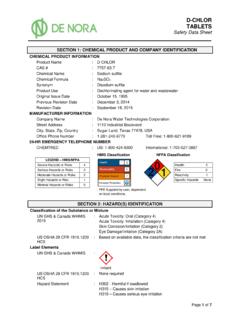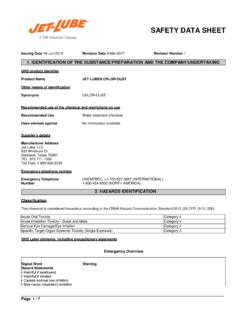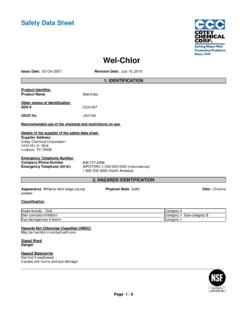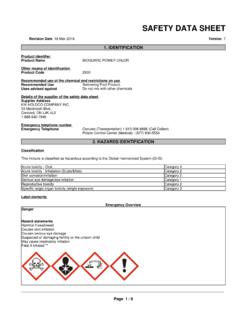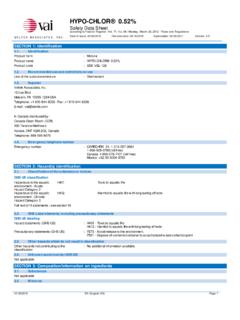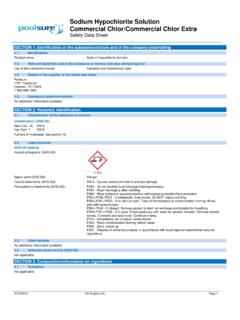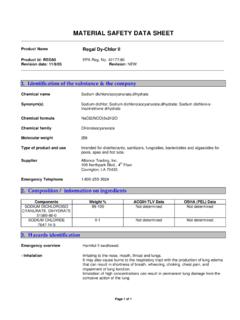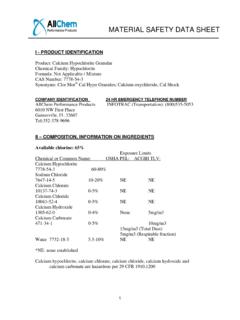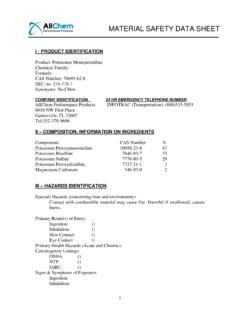Transcription of Chem CHlor MSDS - chemcleantt.com
1 Page 1 of 6 MATERIAL SAFETY DATA SHEET CHEM CHlor Revision Number 4, Revision Date 1. IDENTIFICATION OF THE SUBSTANCE/PREPARATION AND THE COMPANY/UNDERTAKING product Code FAB104BT product Name CHEM- CHlor 12 Synonyms Heavy Duty Chlorinated Alkaline Foam Cleaner Manufacturer and Supplier CHEM CLEAN LTD #1 Trincity Drive Trincity Industrial Estate Trincity Trinidad and Tobago EMERGENCY TELEPHONE NUMBER (868) 662-2615 2. COMPOSITION/ information ON INGREDIENTS CAS CHEMICAL NAME % WEIGHT 1310-58-3 Potassium Hydroxide min 7681-52-9 Sodium Hypochlorite min 3. HAZARDS IDENTIFICATION Emergency Overview: Corrosive Based upon available toxicity information for this and closely related materials, it is anticipated that this material will be harmful if swallowed with possible tissue damage Eye Contact May cause eye irritation Skin Contact May cause chemical burns Inhalation None, if used in adequately ventilated area Ingestion Harmful if swallowed Can cause serious damage to tissues of mouth, throat and stomach if ingested General Advice See First Aid Section Properties affecting Health No effects indicated Principle Routes of Exposure Eye Skin CHEM CHlor 12 Page 2 of 6 4.
2 FIRST AID MEASURES General Advice Show this Safety Data Sheet to the Doctor in attendance Skin Contact Immediately apply vinegar, if readily available Immediately remove contaminated clothing and wash before reuse Immediately flush skin with plenty of cool running water for at least 15 minutes Immediate Medical Attention is required if irritation persists or burns develop Eye Contact In case of eye contact, remove contact lens and rinse immediately with plenty of water, also under the eyelids, for at least 15 minutes Keep eyes wide open while rinsing Immediate medical attention is required Inhalation If affected, move to fresh air If breathing is difficult, give oxygen If not breathing, give artificial respiration Immediate medical attention is required Ingestion If swallowed, immediately drink a large quantity of raw egg, milk or milk of magnesia then drink 3-4 glasses of water Do not induce vomiting Rinse mouth thoroughly Never give anything by mouth to an unconscious person Immediate medical attention is required Aggravated Medical Conditions Pre-existing skin disorder Dermatitis 5.
3 FIRE-FIGHTING MEASURES Flash Point N/A Suitable Extinguishing Media Water spray As appropriate for surrounding fire product will not burn Extinguishing media which must not be used for safety reasons N/A Specific Hazards Cool exposed containers with water spray to prevent pressure build-up Must wear NIOSH approved self-contained breathing apparatus and protective clothing Corrosive material Avoid exposure to mists, dusts and splashes Special exposure hazards arising from the substance, or preparation itself, its combustion products or released gases product will not burn Special Protective Equipment As in any fire, wear NIOSH approved self-contained CHEM CHlor 12 Page 3 of 6 for fire-fighters breathing apparatus and full protective gear Specific Methods Cool containers / Tanks with water spray Fire residues and contaminated fire extinguishing water must be disposed of in accordance with local regulations 6.
4 ACCIDENTAL RELEASE MEASURES Personal Precautions Do not inhale mist, do not in eyes or skin, do not swallow Use personal protective equipment Environmental Precautions Discharge in accordance with Government Regulations Methods for cleaning up Small spills: Wash down with large quantities of water in sanitary sewer Large spills: Dike to prevent runoff. Reclaim as much as possible. Absorb remainder with inert material (sand or vermiculite) and place in compatible container for disposal. Flush residue with large amounts of water into sanitary sewer. Cleaning up personnel should wear appropriate protective equipment 7. HANDLING AND STORAGE Handling Technical Measures/Precautions Avoid contact with skin, eyes Do not inhale mist, do not get in eyes or on skin, do not swallow Safe Handling Advice Avoid contact with skin, eyes Wash hands immediately after contact to avoid hand-eye transfer Do not inhale mist, do not get in eyes or on skin, do not swallow Storage Technical Measures/Precautions Keep containers tightly closed in a cool, dry area.
5 Store in properly labeled containers Do not contaminate water, food or feed Do not reuse empty containers they may contain residues Incompatible Products Avoid contact with concentrated acids may cause violent reactions Avoid contact with aluminum, zinc, other soft metal or galvanized metal Specific use(s) Alkaline foam cleaner 8. EXPOSURE CONTROLS/ PERSONAL PROTECTION Engineering Measures The use of local exhaust ventilation is recommended. Use corrosion-resistant ventilation equipment CHEM CHlor 12 Page 4 of 6 Personal Protective Equipment Hand Protection Neoprene or rubber gloves with cuffs Eye Protection Tightly fitting chemical splash goggles For continued or severe exposure wear a face shield over goggles Safety eyebath nearby Respiratory Protection None, if used in adequately ventilated area In case of insufficient ventilation, wear NIOSH approved respiratory equipment Skin and Body Protection Use chemical protective clothing for repeated or prolonged contact Coveralls, apron, gloves, rubber boots should be worn Hygiene Measures Keep away from food, drink and feed When using, do not eat.
6 Drink or smoke Regular cleaning of equipment, work area and clothing Wear suitable gloves and eye/face protection For environmental protection, remove and wash all contaminated protective equipment before re-use Environmental Exposure Controls Do not inhale mist, do not get into eyes or on skin, do not swallow 9. PHYSICAL AND CHEMICAL PROPERTIES General information Physical State Clear Liquid Color Colorless Odor Chlorine odor Important Health Safety and Environmental information Molecular Wt. N/A pH (1% solution) > Boiling pt > 110 C Specific gravity - Viscosity (CSTS) Not specified Solubility in water 100% Vapor Pressure N/A Vapor Density (AIR=1) N/A Evaporation Rate (WATER:1) N/A Freezing Point N/A Volatile Organic Compounds (Total VOC s) N/A 10.
7 STABILITY AND REACTIVITY Stability Stable under normal conditions Conditions to avoid Adding water to product . Always add product to water Materials to avoid Avoid contact with concentrated acids, may cause violent reactions Avoid contact with aluminum, zinc, other soft metal or CHEM CHlor 12 Page 5 of 6 galvanized metal Hazardous Decomposition Products None determined Polymerization Will not occur 11. TOXICOLOGIAL information Acute Toxicity Component information product information LD50/oral/rat Local effects Skin irritation May cause severe burns Eye irritation Causes sever burns Sensitization Skin sensitizer Specific effects Can cause serious damage to tissues if ingested Carcinogenic Effects None Mutagenic Effects Not determined Reproductive toxicity Not determined Target Organ Effects Tissues 12.
8 ECOLOGICAL information Ecotoxicity effects Component information CAS Chemical Name % Weight N/A N/A N/A product information Aquatic Toxicity: Do not discharge into lakes, streams, ponds or public waterways unless in accordance with Government Regulations. Other information 13. DISPOSAL CONSIDERATIONS Waste from residues/Unused products Do not discharge into lakes, streams, ponds or public waterways unless in accordance with Government Regulations. Consult the Environmental Protection Agency before disposing of any chemicals. Refer to the Environmental Management Authority (EMA) for complete waste disposal regulations on corrosive material Contaminated Packaging Empty containers should be taken for recycling, recovery or waste disposal Further information CHEM CHlor 12 Page 6 of 6 14.
9 TRANSPORT information N/A 15. REGULATORY information N/A 16. OTHER information Literary Reference Sanitizing product Other The information in the Material Safety Data Sheet should be provided to all who will use, handle, store, transport or otherwise be exposed to this product . The information above is believed to be accurate and represents the best information currently available to us. However, we make no warranty of merchantability or any other warranty, express or implied, with respect to such information , we assume no liability resulting from use of msds information . End of Safety data sheet
